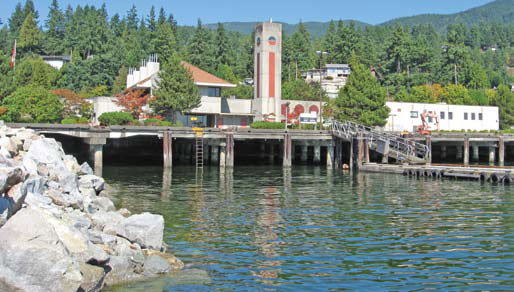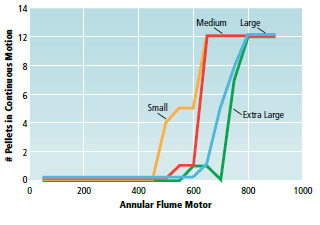Characterizing Benthic Transport and Resuspension of Aquaculture Waste Materials
Issue 2 : September 2011
Summary
To regulate and manage the environmental effects of net pen fish farming operations, it is important to accurately predict the depositional footprint of waste materials beneath and around cages. In many areas, waste depositional models such as DEPOMOD are used to assess sites for licence attribution and site monitoring for license conditions compliance (Cromey et al. 2002 a, b). The predictive capacity of depositional models is dependant on input data based on the nature of waste materials, for example, settling speeds and re-suspension thresholds. The current DEPOMOD re-suspension module may have some practical limitations, since the onset of sediment erosion is derived from a small-sized, slow-settling, synthetic-tracer particle within a low-energy oceanographic setting. To support the development of adjusted model inputs for use along our coastlines, this study examined the settling and re-suspension parameters of Canadian commercial fish feed pellets and the associated faeces. For model refinement, future research is required to enhance these waste transport estimates based on a range of oceanographic (dispersive, quiescent) and benthic (consolidation, roughness, substrate) conditions to provide a predictive tool for industry and regulators.
Introduction
Organic enrichment due to waste feed pellets and faecal matter from marine finfish farms may cause alterations to the existing biodiversity and abundance of benthic faunal communities (Henderson and Ross 1995). These changes are often associated with sediment sulfide production (Wildish et al. 2001) and ammonium release (Hargrave et al. 1993) resulting from waste accumulation beneath fish pens. These concerns have emphasized the need to understand the nature of this effect, as well as the nature and dispersion of the farm waste that is responsible for organic enrichment.
Predicting the dispersal of aquaculture waste through the use of hydrodynamic modeling is necessary to predict and estimate the benthic zone of influence surrounding farm systems. Model predictions can help with site selection and provide research and monitoring tools for the aquaculture industry and regulators. Models have evolved over time from simply predicting fish farm waste accumulation using current data, bathymetric maps, and fish production data (Gowen et al. 1994) to predicting deposition and subsequent benthic transport of waste material through the coupling of complex hydrodynamic and sediment transport modules (Panchang et al. 1997; Dudley et al. 2000). However, a lack of data exists regarding settling rates and transport thresholds of feed pellets and faecal material required for benthic transport model input data. Although some information exists regarding re-suspension thresholds for feed pellets (Sutherland et al. 2006), a comprehensive approach is required to provide estimates for the onset of erosion for both feed and faecal material over a wide range of size and chemical compositions to enable model refinement.
Depositional models are tools that can help support responsible management and sustainable development of the aquaculture industry by allowing regulators to assess potential environmental impacts when granting aquaculture licences. In Canada, the depositional model 'DEPOMOD' is currently used in some regions to assess sites for licence attribution and site monitoring for license conditions compliance. The existing benthic transport and re-suspension module of DEPOMOD uses input values that are based on the dispersion of small-sized, slow-settling, synthetic-tracer particles within a low-energy oceanographic environment. As a result, DEPOMOD-derived predictions regarding depositional footprints may be underestimated in dispersive settings and have the effect of reducing regulatory requirements. The validation and refinement of transport coefficients of farm waste materials, based on currently used commercial feeds and derived faeces, will increase the accuracy of models used to predict waste dispersion around finfish net pens.
| Manufacturer | Feed | Pellet Shape | Type | Sizes Tested |
|---|---|---|---|---|
| Skretting (East Coast) | Optiline Winter / Summer | Cylindrical | Marine | 6 – 12 mm |
| Skretting (West Coast) | Optiline Winter / Summer | Cylindrical | Marine | 6 – 12 mm |
| EWOS | Dynamic Blue | Elliptical | Marine | S, M, L, XL |
| Skretting | BioOregon | Cylindrical | Freshwater | 6 – 12 mm |
Methods
Fish Culture: Atlantic Salmon (400 g) were cultured in two sets of replicate tanks (4000-L) in an outdoor aquarium facility located at Fisheries and Oceans Canada's Centre for Aquaculture and Environment Research (CAER). The salmon were fed to satiation twice a day using a variety of marine fish feed diet types. Steelhead Trout (10-30 g) were reared in the same facility in (200-L) freshwater tanks and were used to test freshwater feed.
Feed Pellets: A variety of commercially available aquaculture feeds, representing diets currently used by the Canadian aquaculture industry, were tested (Table 1). These diets and pellet sizes were evaluated as they represent the dominant product used in the current market, providing a current assessment of waste materials found in the environment.
Faecal Material: Marine faecal material was collected from Atlantic Salmon that were fed successive diets of 9 mm pellets (Skretting Optiline west coast summer/winter diets; east coast winter diet; EWOS Dynamic Blue shaped diet). This pellet size represents the mid-size range of feed used by farm sites during on-site fish grow-out periods. Freshwater faecal material was collected from steelhead trout fed with 2 mm Skretting BioOregon diet.
Settling Rates and Benthic Transport Rates: Size specifications (length, width, and weight) and physical characteristics (moisture and inorganic content) of feed pellets and faecal material were determined. The settling rates of feed pellets were measured using a sedimentation column (Figure 1). Settling rates of faecal material produced from a variety of Atlantic Salmon diets (9 mm pellets) were also determined. Twenty replicate settling trials were carried out for each feed and faecal experiment. Annular flume tank experiments (Figure 2) were carried out to determine benthic traction thresholds (critical onset of movement) and benthic transport rates (m·s–1) of feed pellets and faecal material. (The detailed methodology used in the determination of settling rates, and traction and benthic transport rates is described in Sutherland et al. 2006). The criteria used to define traction threshold was established as the current required to induce continuous movement of ten pellets simultaneously (Sutherland et al. 1998).
Results
Settling Rates and Benthic Transport: The settling rates of feed pellets and faecal material increased with size and weight. The settling rates of faecal materials were 40 – 60% lower than those of fish feed pellets for each diet type (Figure 3), suggesting that density of the waste material may be contributing to the differential settling rates. Figure 4 shows the traction thresholds (critical onset of movement) and benthic transport modes of four pellet sizes.
Traction thresholds were higher for the larger-sized pellets, suggesting that stronger currents are required to move larger pellets. At lower flows, the continuous and simultaneous movement of the larger-sized pellets was impeded by aggregate formations of pellets and subsequent cessation of transport. Alternately, the smaller pellets maintained individual-based transport behaviours (did not form aggregates) and reached traction thresholds at lower speeds. A wide range of transport speeds were observed for various sizes of faecal material. Faecal material appeared to be less stable than feed pellets and exhibited speed 'jumps' when large pieces of the faeces shed into the water (for example, faecal material represented by the dark blue line and * in Figure 5).

Figure 3. Mean settling rates of fish feed pellets and faecal material. WC = west coast Skretting, EC = east coast Skretting.
Conclusion
The accurate prediction of benthic footprints associated with aquaculture waste dispersion models needs to consider a wider spectrum of erosion thresholds and benthic transport rates for various types of fish feed pellets and faecal material. DEPOMOD's current re-suspension module is based on the dispersion properties of a synthetic tracer particle that is characterized by smaller particle size, lower settling rates, and lower re-suspension thresholds than those associated with actual farm waste material. The result is that the DEPOMOD model using the benthic transport module may be amplifying the movement of waste material resulting in a smaller net depositional footprint (post-sedimentation and re-suspension). This study has indicated that the re-suspension module of DEPOMOD may be refined by incorporating the sedimentation and benthic transport values of fish feed pellets and faeces as reported herein. Once modifications are made, validation of the model including simulations for a variety of oceanographic and bathymetric conditions will be required. This will result in an enhanced tool that can be used to predict the environmental effects of aquaculture waste deposition.
References
- Cromey, C.J., T.D. Thomas, and K.D. Black. 2002a. Aquaculture, 214: 211-239.
- Cromey, C.J., T.D. Nickell, K.D. Black, P.G. Provost, and C.R. Griffiths. 2002b. Estuaries, 25: 916-929.
- Dudley, R.W., V.G. Panchang, and C.R.Newell. 2000. Aquaculture, 187: 319-349.
- Gowen, R.J., D. Smyth, and W. Silvert. 1994. Canadian Technical Report of Fisheries and Aquatic Sciences, No. 1949. p. 19-30.
- Hargrave, B.T., D.E. Duplisea, E. Pfeiffer, and D.J. Wildish. 1993. Marine Ecology Progress Series, 96: 249-257.
- Henderson, A.R. and D.J. Ross. 1995. Aquaculture Research, 26: 659-678.
- Panchang, V., G. Cheng, and C. Newell. 1997. Estuaries, 20: 14-41.
- Sutherland, T.F., C.L. Amos, and J. Grant. 1998. Geological Society, London, Special Publications, 139: 295-307.
- Sutherland, T.F., C.L. Amos, C. Ridley, I.G. Droppo, and S.A. Petersen. 2006. Estuaries and Coasts, 29 (5): 810-819.
- Wildish, D.J., B.T. Hargrave, and G. Pohle. 2001. ICES Journal of Marine Science, 58: 469-476.
This PARR Project (PARR-2009-P-04) was also supported by Skretting Canada Inc., EWOS Canada Ltd., the DFO Program for Sustainable Aquaculture, DFO Centre of Integrated Aquaculture Science, and Natural Resources Canada (Atlantic Geological Survey of Canada). The lead scientist on this project, Dr. Terri Sutherland, can be contacted at Terri.Sutherland@dfo-mpo.gc.ca
Published by:
Fisheries and Oceans Canada
Aquaculture Science Branch
Ottawa, ON
K1A 0E6
©Her Majesty the Queen in Right of Canada 2011
DFO/2011-1752
Cat. No. Fs23-570/2011E (Print)
ISBN 978-1-100-18798-3 (Print)
ISSN 1929-7939 (Print)
Cat. No. Fs23-570/2011E-PDF (Online)
ISBN 978-1-100-18799-0 (Online)
ISSN 1928-1013 (Online)
French version and alternative formats available through /aquaculture/parr-prra/index-fra.html.
- Date modified:





